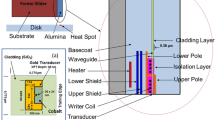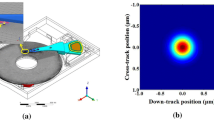Abstract
Heat-assisted magnetic recording (HAMR) is one of prospective high density recording technologies in current hard disk industry due to its theoretical potential. In this paper, we develop a new heat transfer model which enables us to predict near field thermal conduction and radiation across head–disk interface accurately. This new model, together with an Ansys finite element (FE) model for an integrated HAMR slider and an optical absorption model for temperature profile of media hot spot, is then used to solve for temperature rise and thermal protrusion on the slider body. Our simulation studies show that larger hot spot and smaller head–disk spacing will increase the temperature and thermal protrusion on the slider’s head components. When thermal radiation effect is further considered, this increment in temperature and protrusion becomes more significant; especially at very small gap below 1 nm. Therefore, the back heating effect from media hot spot should be addressed carefully for improving the reliability of HAMR head–disk interface.
















Similar content being viewed by others
References
Budaev BV, Bogy DB (2014) Computation of radiative heat transport across a nanoscale vacuum gap. Appl Phys Lett 104:061109
Chen G (2005) Nanoscale energy transport and conversion: a parallel treatment of electrons, molecules, phonons, and photons. Oxford University Press, New York
Greaves SJ, Kanai Y, Muraoka H (2013) Thermally assisted magnetic recording at 4 Tbit/in2. IEEE Trans Magn 49:2665–2670
Huang L, Stipe B, Staffaroni M, Juang JY, Hirano T, Schreck E, Huang FY (2013) HAMR thermal modeling including media hot spot. IEEE Trans Magn 49:2565–2568
Li L, Zheng H, Talke FE (2015) Investigation of Nanoscale heat transfer and flying characteristics in thermal flying height control sliders considering near-field radiation. Tribol Lett 59(12):1–7
Mansuripur M, Connell GAN, Goodman JW (1982) Laser-induced local heating of multilayers. Appl Opt 21(6):1106–1114
Mulet JP, Joulain K, Carminati R, Greffet JJ (2002) Enhanced radiative heat transfer at nanometric distances. Microscale Thermophys Eng 6:209–222
Myo KS, Zhou W, Huang X, Yu S (2015) Numerical investigation of thermal effects on a HAMR head–disk interface. Microsyst Technol 21:2641–2647
Narayanaswamy A, Shen S, Hu L, Chen X, Chen G (2009) Breakdown of the Planck blackbody radiation law at nanoscale gaps. Appl Phys A 96:357–362
Shen S, Narayanaswamy A, Chen G (2009) Surface phonon polaritons mediated energy transfer between nanoscale gaps. Nano Lett 9:2909–2913
Stipe BC, Strand TC, Poon CC, Balamane H, Boone TD, Katine JA, Li JL, Rawat V, Nemoto H, Hirotsune A, Hellwig O, Ruiz R, Dobisz E, Kerche DS, Robertson N, Albrecht TR, Terris DB (2010) Magnetic recording at 1.5 Pb m−2 using an integrated plasmonic antenna. Nat Photon 4:484–488
Yu P, Zhou W, Yu S, Myo KS (2013a) Modeling laser heated thin film media for heat assisted magnetic recording. Microsyst Technol 19:1457–1463
Yu P, Zhou W, Yu S, Zeng Y (2013b) Laser-induced local heating and lubricant depletion in heat assisted magnetic recording systems. Int J Heat Mass Transf 59:36–45
Yu P, Zhou W, Yu S (2015) Effect of the thickness of a diamond-like carbon layer on the local temperature increase in a multilayered structure induced by laser heating. Numer Heat Transf A 67:791–807
Zhang S, Bogy DB (1999) A heat transfer model for thermal fluctuations in a thin slider disk air bearing. Int J Heat Mass Transf 42:1791–1801
Zheng H, Zhang S, Yan W, Pust L, Fowler D, Talke FE (2010) The effect of thermal radiation on thermal flying height control sliders. IEEE Trans Magn 46:2376–2378
Zheng H, Li H, Talke FE (2012) Numerical simulation of thermal flying height control sliders in heat-assisted magnetic recording. Microsyst Technol 18:1731–1739
Zhou W, Liu B, Yu S, Hua W, Wong CH (2008) A generalized heat transfer model for thin film bearings at head–disk interface. Appl Phys Lett 92:043109
Zhou W, Wong CH, Liu B, Yu S, Hua W (2009) Effects of temperature dependent air properties on the performances of a thermal actuated slider. Tribol Int 42:902–910
Acknowledgments
This work is supported by the ‘Scientific Staff Development Award’ from Data Storage Institute, Agency for Science, Technology and Research (A*STAR) Singapore, awarded to K. S. Myo. The authors would like to thank Dr. S. Yu and Dr. W. Hua for discussions and comments to improve the manuscript.
The author P. Yu would like to thank the financial support from National Natural Science Foundation of China (Grant No. 11542015).
Author information
Authors and Affiliations
Corresponding author
Rights and permissions
About this article
Cite this article
Myo, K.S., Zhou, W., Huang, X. et al. Back heating effect of media hot spot at nanoscale head–disk interface. Microsyst Technol 23, 2587–2597 (2017). https://doi.org/10.1007/s00542-016-3107-9
Received:
Accepted:
Published:
Issue Date:
DOI: https://doi.org/10.1007/s00542-016-3107-9




